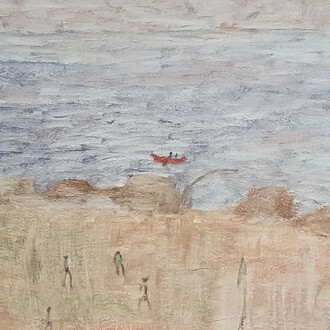Juliana Góngora Rojas is a Colombian sculptor who engages with organic materials, such as soil, salt, stones, or spider threads.
Interested in establishing networks of community and spiritual exchange, Góngora collaborates with artisans, farmers, and Indigenous communities in works that emphasize the importance of ordinary materials and daily actions, as well as the ties that intimately bind human beings with nature.
For her first exhibition at a major institution in the United States, Góngora has invited fellow artist Matías Quintero Sepúlveda and Juven and Yinela Piranga Valencia, leaders of the Ko’revaju Indigenous community of the Northern Colombian Amazon, to create an installation that honors the ongoing dialogue and spiritual collaboration that they have collectively sustained over several years. Weaving together earth, its pigments, milk, plant fibers, and seeds, the artists and community leaders give form to their shared vision of interconnectedness, collectivity, and creation.
An artwork made of a slab of organic material that looks to be cracked clay. It fills the field of vision; its outer edges and shape cannot be seen. The clay in the bottom half is deep brown, while the upper half is light beige. The line of demarcation is rough and organic, like an eroding beachline. Extending from the top down toward the rough line are numerous small dark-brown dabs in a gridlike pattern, roughly forming the bottom portion of a rectangle.
At the heart of the exhibition are two works that together represent a complete universe, heavens and earth, womb and seed: the textile Manto celeste (Celestial cloth), whose sand-based blue pigmentation represents motherhood, water, and the cosmic sky, and the burnished soil installation Piso de tierra (Earth floor).
Other objects in the exhibition are made with sacred materials native to the Colombian territory that is home to the Ko’revaju community and displayed in ways that honor their traditional uses. Accompanying the installation is a text written by all four makers—”a word of encouragement” for visitors—that appears in Ko’revaju and Spanish with English translation and stresses the human task of preserving and caring for our common mother, Mother Earth.
Installation view of three hanging sculptural textiles. The two at right, one larger and one much smaller, are similar, each composed of a beige-toned woven cone at top and numerous wispy fibers dangling down in yellow and beige. The object at left is about the size of the smaller one at right, but its tail is much shorter, its tone medium-brown, and its upper cone rounder and more loosely woven. La palabra dulce (The Sweet Word), 2023–25
Together, the works in the exhibition make up a “cosmic weaving,” which reflects the collaborators’ experiences of the innate ties between humanity and our shared environment. They extend an invitation to recognize ourselves as guardians and stewards of everything that surrounds us, through collectivity and ritual in the shared space of the museum.
















